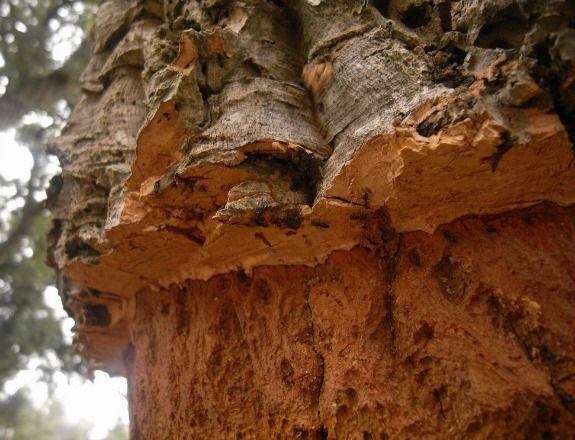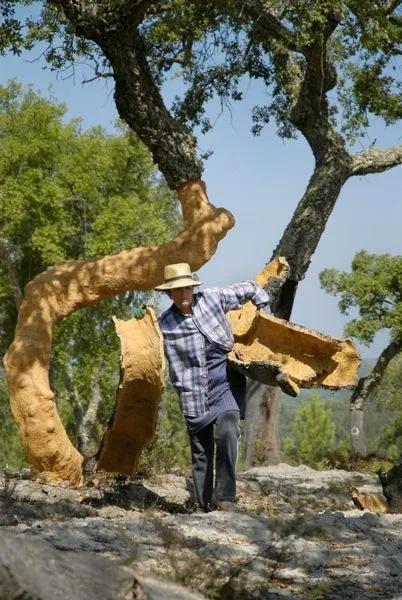Cork Trees: Soft-Skinned Monarchs of the Mediterranean
A cork tree stripped of its bark will be harvested again in nine years—if people are still using cork by then
/https://tf-cmsv2-smithsonianmag-media.s3.amazonaws.com/filer/20120628114029CorkTreeSpainSMALL.jpg)
A person sees many countries on a European tour—and I don’t necessarily mean those divided by political boundaries and languages. I mean truffle country, sweet wine country, bear country, bike country, tax-free perfume country, cider country, salmon country and Basque country.
Further to the south, on the sweltering, blistering hot plains west and south of Madrid, the traveler finds the stately old monarchs of cork country. It’s not the grandest claim to fame for a landscape—its parched soils produce oak trees whose spongy bark will be cut up and plugged into wine bottles. But the corks of Spain and Portugal have played a key role in the making of wine for 200-plus years. The trees are beauties. They assume a huge girth over the centuries that they stand on these interior plains, and in a country where the summer sun all but sets the land on fire (I’m here now, and it’s 105 degrees in the sun, 80 in an air-conditioned hotel room), their shade is precious. Readers may know the story of Ferdinand, the great and gentle bull who lazed away the blazing Spanish days in the shade of his favorite cork tree.
The cork tree’s bark is a thick spongy hide that is stripped stripped away by workers using knives and axes once every nine years—the normal time it takes for the tree to recover. A number is often spray painted on the tree to indicate the year in which it was last harvested. The average specimen of Quercus suber produces about 100 pounds of cork in a stripping, while the very largest tree—named the Whistler Tree, 45 feet tall and a resident of Portugal’s Alentejo region—produced a ton of bark at its last harvest in 2009. It was enough for about 100,000 corks—enough to plug up the entire annual sweet wine production of Chateau d’Yquem.

The Whistler Tree is the oldest known cork tree. It sprouted from its acorn 20 years before Lewis and Clark described the Rocky Mountains and produced its first cork crop in 1820. But even the youngest trees of cork-producing age (they aren’t harvested until they’re about 25 years old, and the first two harvests are often unsuitable for use as bottle stoppers) date back to the years before the advent of the screwcap—which puts a, um, twist into this story. For that little aluminum artifice of convenience for the wine drinker has become enemy number one of the cork industry, which employs tens of thousands of people full time or seasonally. And things look bleaker than even the desert plains of La Mancha for the Mediterranean’s five million acres of cork country. A report from World Wildlife Fund in 2006 predicted that by 2015—just three years away—95 percent of all wine bottles would be sealed with screwcaps, plugged with synthetic corks or packed as “bag-in-box” wines. That report remains the official prophecy of the future of corks.
This could mean the chainsaw for many of the trees, as their owners turn to more profitable uses of the land—and you can’t blame winemakers for seeking cork alternatives. Because cork taint, a condition that plagues even the greatest, most consistent wineries, makes as many as 15 bottles in 100 unpleasant, sometimes undrinkable. Cork taint is caused by “TCA” (or 2,4,6-trichloroanisole), a product of bacterial growth that occurs in the living bark of Quercus suber and which may be transferred to the wine if a cork is improperly sterilized. Screwcaps and other cork alternatives eliminate this risk. Many wine producers may never abandon the cork, which some say can positively affect the flavor of a wine and facilitate bottle maturation by allowing oxygen and other compounds to enter and exit through the porous cork. But some regional wine industries have have entirely shifted into the cork-free future. In New Zealand, when I visited the home of a friend in March, I picked up a bottle of a local Cabernet Sauvignon, harvested late in the Clinton era and plugged with a real cork. Today, virtually no wineries in New Zealand use corks, and when I showed my friend the bottle, she said, “But how are we going to open it?” Her household did not contain a corkscrew.
If the cork forests vanish, wildlife including lynx, red deer and pigs would lose their homes, and in Portugal alone more than 60,000 people might lose their jobs as the cork industry sink—like a rock. And instead of a sustainably harvested and biodegradable product, we would have synthetic replacements made of factory metal and plastic. Otherwise, most of us wouldn’t be affected, except that in fancy restaurants we wouldn’t get to feign scrutiny anymore when the waiter offers the wine cork to be smelled. And, of course, it would be a shame to lose the trees, whose shade in these parts, I assure you, is more precious than any wine.
Want to see a few cork trees and some real cork harvesting in action? In summertime, the highways through the Alentejo region of eastern Portugal and the bordering region of Extremadura in Spain are the places to be. Tourist services even offer guided bus trips deep into cork country, specifically to watch men and women stripping the trees, followed by a visit to a cork factory in Lisbon. Also to be expected are fine food and wine—probably not from screwcapped bottles, but watch closely. And a Portuguese cycle-touring company, Blue Coast Bikes, gears guests up for bike rides through the cork country, mostly to see castles and grapevines, but the cork trees are there, if for no purpose at all but to be enjoyed.

/https://tf-cmsv2-smithsonianmag-media.s3.amazonaws.com/accounts/headshot/Off-Road-alastair-bland-240.jpg)
/https://tf-cmsv2-smithsonianmag-media.s3.amazonaws.com/accounts/headshot/Off-Road-alastair-bland-240.jpg)